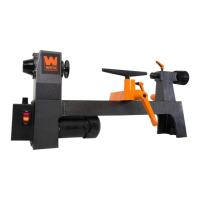PROBLEM CAUSE SOLUTION
Motor or spindle stalls and will
not start.
1. Excessive cut 1. Reduce the depth of the cut.
2. Worn, damaged, or improperly adjusted belt. 2. Adjust or replace the belt.
3. Worn spindle bearing. 3. Replace the bearing.
4. Workpiece is too large; lathe is protecting
itself.
4. Switch to a smaller workpiece.
5. Carbon brushes are worn. 5. Check and replace carbon brushes if needed.
6. Fuse is blown. 6. Replace fuse (on rear of control box).
Excessive vibration.
1. Workpiece is warped, out of round, has major
flaw, or was improperly prepared for turning.
1. Correct the problem by planing or sawing
workpiece, or discard it entirely and restart.
2. Worn spindle bearing. 2. Replace the spindle bearings.
3. Worn drive belt. 3. Replace the drive belt.
4. Lathe is on an uneven surface.
4. Place the lathe on a flat surface, such as a
benchtop or lathe stand.
Tools tend to grab or dig in.
1. Dull tools. 1. Keep tools sharp.
2. Tool rest set too low. 2. Reposition the tool rest height.
3. Tool rest set too far from work piece.
3. Reposition the tool rest closer to the
workpiece.
4. Improper tool being used. 4. Use correct tool for operation.
Tailstock moves when applying
pressure.
1. Cam lock nut needs adjusting.
1. Contact customer service (1-800-232-1195,
M-F 8-5 CST) for assistance.
2. Lathe bed and tailstock mating surfaces are
greasy or oily.
2. Remove the tailstock and clean the surfaces
with a cleaner. Apply a light coat of oil to the
lathe bed surface.
MAINTENANCE
Keep your machine clean. At the end of each day, clean the machine. Wood contains moisture, meaning that saw-
dust and wood chips can cause rust if not removed. Regular oil attracts dust and dirt. Teflon lubricant tends to dry
and has less of a tendency to accumulate dirt and saw dust. Periodically check that all nuts and bolts are tight.
The drive belt should last for many years depending on usage, but it needs to be inspected regularly for cracks, cuts
and general wear. If damage is found, replace the belt before operation.
All bearings are sealed for life and do not require any maintenance. If a bearing becomes faulty, replace it.
The lathe is made from steel and cast iron. All non-painted surfaces will rust if not protected. Apply a light coat of
good-quality paste wax to all machined surfaces to protect against rust and corrosion.
Blow out dust accumulation inside the motor, the housing, and the bed assembly frequently. If the tailstock has been
used as a guide for drilling through the center of a workpiece, also blow sawdust or shavings out of the center of
both the headstock spindle and the tailstock quill.
A coat of machine lubricant applied to the bed will help keep the surface clean and the movement of the tool rest
and tailstock smooth.
Periodic lubrication of the spring levers and other threaded parts will make these parts easier to operate.
TROUBLESHOOTING GUIDE
18

